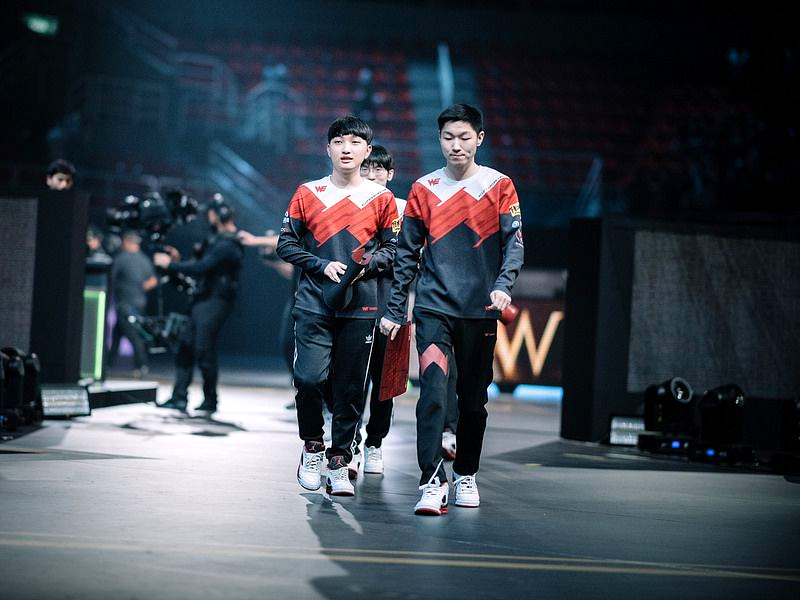Heading into this year’s Mid Season Invitational, Western pundits predicted Team WE to end the group stage in fourth place, just barely making the semifinals.
Despite WE’s dominating 3-0 sweep against Royal Never Give Up in the LPL finals, many believed that the Chinese representatives wouldn’t be able to rectify their problems in time for MSI. WE faced plenty of problems throughout the Spring Split, from blind early aggression to an inability to close out games until 40 minutes.
But to everyone’s surprise, WE blazed through the group stage. Flash Wolves, largely considered the second best team at MSI, couldn’t even take a game off the Taiwanese team.
And SK Telecom T1, the clear tournament favorite, suffered one of their two losses to a WE mid Lucian composition.
By the end of the MSI group stage, WE sat firmly in second place, with a match record of 7-3—just one win away from matching SKT’s 8-2 record.
So how were WE able to perform to such a high level, proving the community and experts wrong?
957 came to play
Ke “957” Chang-Yu had little hype around him moving into MSI.
Unlike other teams at the tournament, such as TSM or SKT, WE’s main focus was their mid and bot lane. Xiang “Condi” Ren-Jie’s usual jungle pathing would revolve around the bottom half of the map, hoping to get the carries fed early into the game. For 957, this caused him to be given the “Dyrus treatment,” where he would be left alone on the island known as the top lane, forced to fend for himself.
Because of this playstyle, when WE loaded onto Summoner’s Rift for their first match at MSI, the analysts were more focused on the Chinese carries than 957.
But piloting the Kled, a champion he went undefeated with during the LPL playoffs, 957 proceeded to demolish first Yu “MMD” Li-Hong and, later, the entirety of the Flash Wolves.
And this fantastic play by 957 continued throughout the entirety of the group stage. Enabled by his team to play carries like Kled and later Fizz, 957 outplayed his opponents time and time again.
Because 957 led his position at MSI in KDA, kill participation, and gold differential at 10 minutes, there’s a case to be made that he was the best-performing top laner during the group stage. And now pitted against G2’s Ki “Expect” Dae-han, who in contrast struggled at MSI, there’s no reason to think that 957 won’t carry this high-level play into the semifinals.
A learned Condi
Unlike 957, Condi had a ton of eyes watching him at MSI. Considered the best Chinese jungler (alongside RNG’s Liu “Mlxg” Shi-Yu), Condi was finally given a chance to go against some of the best junglers from the other major regions.
Although the community was excited to see Condi play on the international stage, many were concerned about how he would perform. In China, Condi was known for his reckless early invades. Even if he didn’t have winning lanes, Condi would attempt an invade, and more often than not getting killed for it. While it wasn’t the biggest flaw to have playing domestically, against the likes of Han “Peanut” Wang-ho and Hung “Karsa” Hau-Hsuan, Condi’s invades could cost WE the game.
Surprisingly, at MSI Condi shored up this problem. Instead of getting caught in the enemy jungle, Condi was now the one catching other junglers trying to invade.
And with these resolved mistakes came much better early ganks from Condi. Now with even better pathing, Condi could find early first blood kills for his laners. The most notable example of this came from WE’s rematch with SKT. Condi cleared his early camps faster than Peanut, and thus could gank mid lane before Peanut finished taking his blue buff. If not for the early double kill Condi gifted to Su “xiye” Han-Wei, WE probably wouldn’t have won that game.
On top of the meta
Both 957 and Condi had standout performances during the group stage. But it was the team’s total grasp of the tournament meta that solidified WE as the clear second seed at MSI.
During the LPL playoffs, WE’s bread-and-butter were protect-the-AD-carry-compositions. Either Xiye or Nam “Ben” Dong-hyun played Karma or Lulu, and would use their shields to protect Jin “Mystic” Seong-jun, who was almost always on an immobile hyper carry like Ashe or Kog’maw. But despite the enormous success WE found playing this specific composition type, other regions didn’t catch on. That is, until MSI.
Teams finally realized just how strong this composition was in the current meta, and every team was forced to adapt in time for the group stage.
Every team except WE.
Already veterans of the protect-the-AD-carry composition, WE felt right at home playing at MSI. WE could take advantage of the likes of the Gigabyte Marines and Flash Wolves, two teams who had difficulties playing this new style, earning easy wins.
But now a week has passed since the MSI group stage began, and WE’s competition have adapted to the new meta. Against Europe’s G2 in the semifinals of MSI, WE are one best-of-five away from reaching the organization’s first international final since IEM Katowice 2015, over two years ago.
WE have shown they can beat the best in a single game. Now it’s time to see if they can do the same in a series.
Player statistics taken from Oracle’s Elixir.

